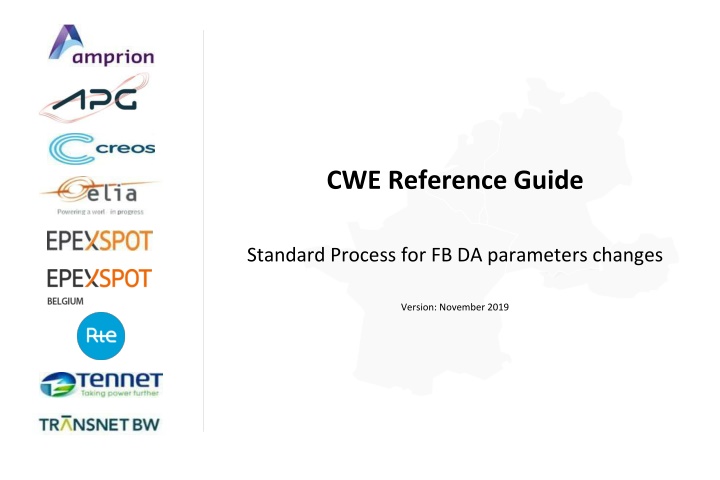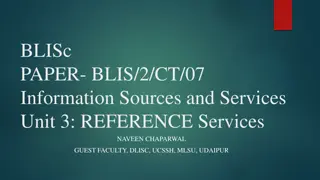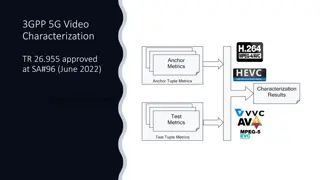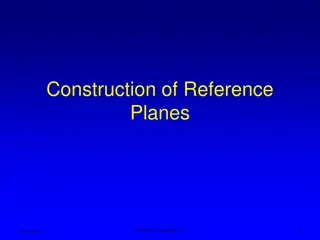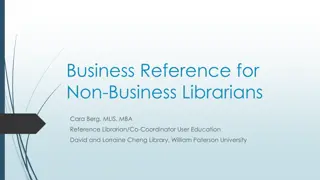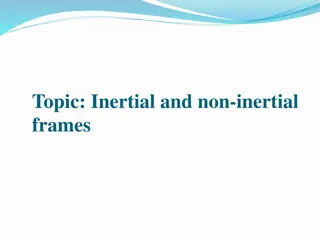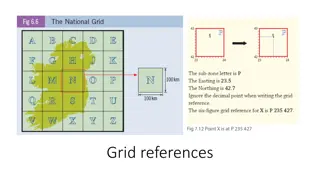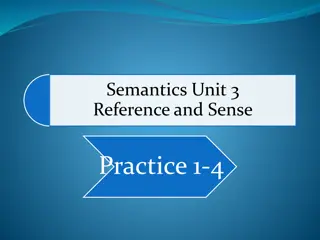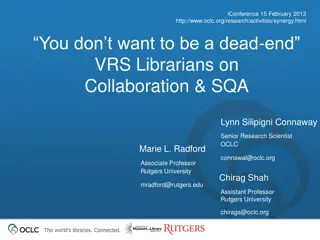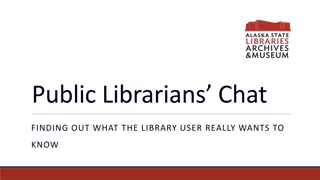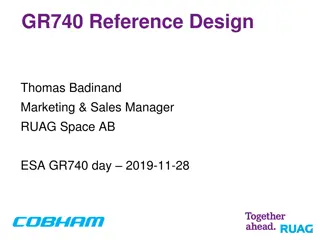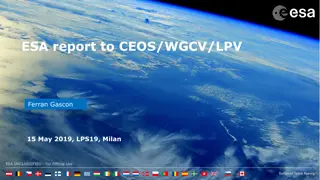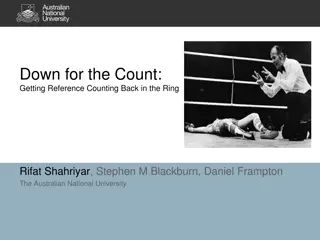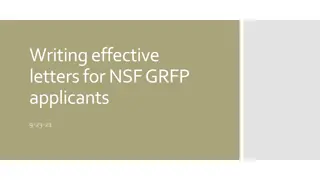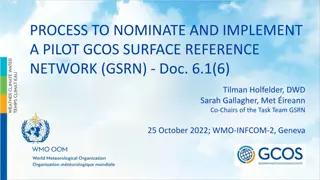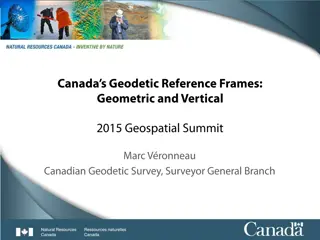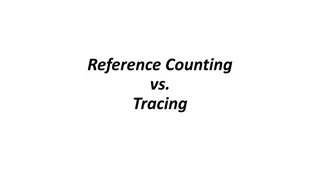CWE Reference Guide
The CWE Reference Guide outlines the standard process for making changes to FB DA parameters, focusing on impact assessment and communication requirements for various types of changes such as new grid elements, methodological changes, commissioning/decommissioning units, and more. The guide provides detailed information on different types of changes, including expected outages, GSKs methodology adjustments, removal of external constraints, and more.
Download Presentation

Please find below an Image/Link to download the presentation.
The content on the website is provided AS IS for your information and personal use only. It may not be sold, licensed, or shared on other websites without obtaining consent from the author.If you encounter any issues during the download, it is possible that the publisher has removed the file from their server.
You are allowed to download the files provided on this website for personal or commercial use, subject to the condition that they are used lawfully. All files are the property of their respective owners.
The content on the website is provided AS IS for your information and personal use only. It may not be sold, licensed, or shared on other websites without obtaining consent from the author.
E N D
Presentation Transcript
CWE Reference Guide Standard Process for FB DA parameters changes Version: November 2019 1
Table of content 1. CWE TSO Program Reference Guide FB DA parameter changes ID ATC after FBMC parameter changes 2. CWE full SPAIC approach Approach Selection of typical days FB Parameter creation & Market Coupling simulations 3. CWE light SPAIC approach Approach Selection of reference days & process 2
1. CWE TSO Program Reference Guide FB DA parameter changes 1-2 Following planned operational changes, there can be different requirements for the impact assessment to be performed and/or communication required to the market. TSOs distinguish the below relevant FB DA parameter changes and related required assessment and communication: # Type of change Impact assessment Communication Comments 1 New cross-border grid element Full SPAIC SPAIC report 2 GSKs methodology: Change in method or significant impact Full SPAIC SPAIC Report Change in GSK method or significant change requires SPAIC. 3 Commissioning/decommissioning of units Full SPAIC (In case significant impact on cross border capacities) Unit commissioned and/or decommissioned and expected duration 4 Advanced hybrid coupling and/or extension CWE Full SPAIC SPAIC report 5 New internal CNEs (or change in physical assets) New internal assets directly connected to cross-border lines New Critical Network Elements used for capacity calculation Light SPAIC For new assets Light SPAIC Report When a new CNE is added, this is seen as significant. In case the introduction of temporary CNEs (operational reasons) is smaller than time needed for a light SPAIC, it will be limited to communication 3
1. CWE TSO Program Reference Guide FB DA parameter changes 2-2 # Type of change Impact assessment Communication Comments 6 Expected outages Light SPAIC (In case significant impact on cross border exchanges) Line in outage, expected duration, period and possible high-level estimation on impact for capacity calculation Maintenance for more than six weeks and permanent out-of- service for the whole period For all other cases, it will be limited to communication 7 GSKs methodology: small changes in sharing keys n/a relative changes Small changes in sharing keys should be communicated to explain relative changes. 8 External constraints (import/export limit) n/a value and duration 9 CNEC removal n/a Market message to inform on a CNEC removed with a link to Human Readable Name Removal requires only communication 10 FRM (Flow Reliability Margin) n/a Market message to inform on relative changes, linked to Human Readable Name 11 FAV (excl. LTA inclusion) n/a Market message to inform on operationally applied FAV (if preferred) For longer-term: Information on relative change and link to Human Readable Name 12 Seasonal Changes n/a Market message to inform on relative changes, linked to Human Readable Name 4
1. CWE TSO Program Reference Guide ID ATC after FBMC parameter changes TSOs distinguish the below relevant ID ATC after FBMC parameter changes and related required assessment and communication: # Type of change Impact assessment Communication Comments 1 New border within ID CMT n/a Market message with information like: - Border - Values - Go-live date (business day) 2 A new maximum increased value within ID CMT per border and direction n/a Market message with the changed value per border and direction Go-live date (business day) 3 Publishing timings (the first time that market parties see the updated capacity) n/a Market message with update timings. Go-live date (business day) 4 Changes of internal TSO tooling with direct impact on cross border capacities n/a Market message with description of the changes and impact on the process 5
2. CWE full SPAIC approach In general there are 2 possible workflows for the full SPAIC approach: SPAIC which is carried out individually (e.g. Mercator-Horta SPAIC) or bilaterally (e.g. Doetinchem Niederrhein SPAIC). SPAIC which is carried out jointly and requires decision making on CWE level. 1. 2. 1. Individual / bilateral full SPAIC The trigger can be e.g. update of a methodology or the introduction of a new cross-border grid element (see also slides with list of changes) In this process a distinction is made for whether or not a decision related to the change is already taken by the respective TSO(s). This is relevant, because: In case a decision is taken and this decision impacts the market, according to REMIT, market parties and NRAs need to be notified. In the case a decision is not yet made and is still under discussion, market parties and NRAs do not yet have to be notified. It is assumed that individual CWE TSOs are able to determine whether or not a decision on CWE level is needed for a certain change. In any case, CWE TSOs should be pro-actively involved (for information) by the individual TSO(s) carrying out the individual / bilateral SPAIC. o o o 2. Joint full SPAIC Trigger can be a common CWE TSOs requirement with a change to methodology or a NRAs or market parties request (see also slides with list of changes) A common CWE TSOs decision is required to perform a joint SPAIC. 6
2. CWE full SPAIC approach Communication on full SPAIC Communication to market parties: CWE TSOs will communicate to MPs via the CWE Consultative Group meeting, JAO website and/or email notification once a decision is taken on the foreseen change. It is agreed with MPs and NRAs to provide relevant information as soon as possible but latest 1 week in advance of a change implementation or prior to a stakeholder meeting. MPs will be informed via a market message when in exceptional cases the SPAIC report will be published after the implementation of the change Communication to NRAs: CWE TSOs will align on & communicate common changes with NRAs via the CWE NRA expert meetings and via email. Important: the non-timely publication of a SPAIC cannot lead to non-implementation of the change Preserving the grid security has the highest priority (e.g. grid changes that require an update of CNEC lists). New assets should not be delayed by the SPAIC process. o o o o o 7
2. CWE full SPAIC approach Selection of typical days Once the full SPAIC has been launched, CWE TSOs run the standard approach process based on a set of 12 representative typical days: 3 winter weekdays 1 winter weekend day 3 summer weekdays 1 summer weekend day 3 interseason weekdays 1 interseason weekend day The 12 typical days will be updated every time an impact assessment is launched and will be considered as valid for a period of 6 months (i.e. after this period of time, the categories would need to be updated in case a new impact assessment is launched) E.g. for an impact assessment launched in February 2020, the categories of typical days will be defined based on data from January 2019 to December 2019. 8
2. CWE full SPAIC approach FB Parameter creation & Market Coupling simulations Orders books for Market simulations The 12 typical days will be mapped against all order books of the same period, so these are available for Market simulations that will be performed on three datasets: Flow based parameters 1. Historical benchmark:FB parameters for the 12 typical days no modifications 2. Updated historical benchmark: (possible) Updated FB parameters for the 12 typical days modified to reflect already implemented changes prior to the new change which is investigated in the SPAIC 3. New FB parameters: new FB parameters for the 12 typical days modified to reflect the already implemented changes and the new change Market simulations will be performed on all three datasets Impact assessment process Benchmark data FB parameters for the 12 typical days One-year market impact reference 1 year of FB data categorized in 12 typical days All order books can be mapped to one of the 12 typical days Analyze market results with reference indicators One-year market impact reference for updated parameters* Updated FB parameters for the 12 typical days* 1 year order books New FB parameters for the 12 typical days One-year market impact for new change * New benchmark data could be created in case a new known change occurs during the period when the impact assessment is performed Change analysis 9
3. CWE light SPAIC approach In general there are 2 possible workflows for the light SPAIC approach: SPAIC which is carried out individually (e.g. Mercator-Horta SPAIC) or bilaterally (e.g. Doetinchem Niederrhein SPAIC). SPAIC which is carried out jointly and requires decision making on CWE level. 1. 2. 1. Individual / bilateral light SPAIC The trigger can be e.g. the implementation of a new asset (see also slides with list of changes). In this process a distinction is made for whether or not a decision related to the change is already taken by the respective TSO(s). This is relevant, because: In case a decision is taken and this decision impacts the market, according to REMIT, market parties and NRAs need to be notified. In the case a decision is not yet made and is still under discussion, market parties and NRAs do not yet have to be notified. It is assumed that individual CWE TSOs are able to determine whether or not a decision on CWE level is needed for a certain change. In any case, CWE TSOs should be pro-actively involved (for information) by the individual TSO(s) carrying out the individual / bilateral SPAIC. Important: Non-timely publication of SPAIC cannot lead to a non implementation of the change Preserving the grid security has highest priority (e.g. grid changes that require an update of CBCO lists) New assets should not be delayed by the SPAIC process o o o o o 2. Joint light SPAIC Trigger can be a common CWE TSO requirement with a change to methodology or a NRAs or market parties request (see also slides with list of changes). Common TSO decision required for joint SPAIC 10
3. CWE light SPAIC approach Communication Communication to MPs: CWE partners will communicate to MPs via CCG meeting, JAO website and/or email notification. It was agreed with MPs and NRAs to provide relevant information as soon as possible but latest 1 week in advance of a change implementation or prior to a stakeholder meeting. Market parties will be informed via a market message when in exceptional cases the SPAIC will be published after the implementation of the change Communication to NRAs: CWE partners will align & communicate common changes with NRAs via the NRA expert meetings and email o o o 11
3. CWE light SPAIC approach Selection of reference days & process Once the light SPAIC has been launched, CWE TSOs calculate 7 days with different grid situations to provide as much information as possible to MPs and NRAs: Day 1: Sunday in the available period with the lowest wind infeed in CWE (DE to be taken as proxy) Low load/loadflow situation. Day 2: Workday in the available period with the highest wind infeed in CWE (DE to be taken as proxy) High load/loadflow situation. Day 3: Any workday or Saturday in the available period with average wind/load. Day 4-5: Smallest/largest flow based domain (volume) Day 6-7: Lowest/highest exchanges in CWE (sum of positive Net Positions after market coupling). CWE TSOs use the following timeline for the light SPAIC process: W-7-4: Publication of a market message when the 7 days have been picked to inform MPs about the ongoing light SPAIC W-11: Start of the period (7 days ) W-0: Go-live of the change W-7: End of the period (7 days ) W-1-4: Publication of the SPAIC 11 10 9 8 7 6 5 4 3 2 1 7 days are coming from these 4 weeks Pick the 7 days & perform CC for 7 days 12
